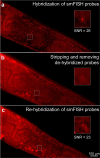Rapid and multi-cycle smFISH enabled by microfluidic ion concentration polarization for in-situ profiling of tissue-specific gene expression in whole C. elegans
- PMID: 31700560
- PMCID: PMC6824911
- DOI: 10.1063/1.5124827
Rapid and multi-cycle smFISH enabled by microfluidic ion concentration polarization for in-situ profiling of tissue-specific gene expression in whole C. elegans
Abstract
Understanding gene regulation networks in multicellular organisms is crucial to decipher many complex physiological processes ranging from development to aging. One technique to characterize gene expression with tissue-specificity in whole organisms is single-molecule fluorescence in situ hybridization (smFISH). However, this protocol requires lengthy incubation times, and it is challenging to achieve multiplexed smFISH in a whole organism. Multiplexing techniques can yield transcriptome-level information, but they require sequential probing of different genes. The inefficient macromolecule exchange through diffusion-dominant transport across dense tissues is the major bottleneck. In this work, we address this challenge by developing a microfluidic/electrokinetic hybrid platform to enable multicycle smFISH in an intact model organism, Caenorhabditis elegans. We integrate an ion concentration polarization based ion pump with a microfluidic array to rapidly deliver and remove gene-specific probes and stripping reagents on demand in individual animals. Using our platform, we can achieve rapid smFISH, an order of magnitude faster than traditional smFISH protocols. We also demonstrate the capability to perform multicycle smFISH on the same individual samples, which is impossible to do off-chip. Our method hence provides a powerful tool to study individual-specific, spatially resolvable, and large-scale gene expression in whole organisms.
Copyright © 2019 Author(s).
Figures





Similar articles
-
High-Temporal-Resolution smFISH Method for Gene Expression Studies in Caenorhabditis elegans Embryos.Anal Chem. 2021 Jan 26;93(3):1369-1376. doi: 10.1021/acs.analchem.0c02966. Epub 2020 Dec 23. Anal Chem. 2021. PMID: 33355449 Free PMC article.
-
Improved Methods for Single-Molecule Fluorescence In Situ Hybridization and Immunofluorescence in Caenorhabditis elegans Embryos.Curr Protoc. 2021 Nov;1(11):e299. doi: 10.1002/cpz1.299. Curr Protoc. 2021. PMID: 34826343 Free PMC article.
-
smFISH in chips: a microfluidic-based pipeline to quantify in situ gene expression in whole organisms.Lab Chip. 2020 Jan 21;20(2):266-273. doi: 10.1039/c9lc00896a. Epub 2019 Dec 2. Lab Chip. 2020. PMID: 31788681 Free PMC article.
-
HT-smFISH: a cost-effective and flexible workflow for high-throughput single-molecule RNA imaging.Nat Protoc. 2023 Jan;18(1):157-187. doi: 10.1038/s41596-022-00750-2. Epub 2022 Oct 24. Nat Protoc. 2023. PMID: 36280749 Review.
-
Computational solutions for spatial transcriptomics.Comput Struct Biotechnol J. 2022 Sep 1;20:4870-4884. doi: 10.1016/j.csbj.2022.08.043. eCollection 2022. Comput Struct Biotechnol J. 2022. PMID: 36147664 Free PMC article. Review.
Cited by
-
Advancements in Genomic and Behavioral Neuroscience Analysis for the Study of Normal and Pathological Brain Function.Front Mol Neurosci. 2022 Jun 23;15:905328. doi: 10.3389/fnmol.2022.905328. eCollection 2022. Front Mol Neurosci. 2022. PMID: 35813067 Free PMC article. Review.
-
Liquid biopsy technologies based on membrane microfluidics: High-yield purification and selective quantification of biomarkers in nanocarriers.Electrophoresis. 2020 Nov;41(21-22):1878-1892. doi: 10.1002/elps.202000015. Epub 2020 Apr 9. Electrophoresis. 2020. PMID: 32180242 Free PMC article. Review.
-
High-Temporal-Resolution smFISH Method for Gene Expression Studies in Caenorhabditis elegans Embryos.Anal Chem. 2021 Jan 26;93(3):1369-1376. doi: 10.1021/acs.analchem.0c02966. Epub 2020 Dec 23. Anal Chem. 2021. PMID: 33355449 Free PMC article.
-
Enabling high-throughput single-animal gene-expression studies with molecular and micro-scale technologies.Lab Chip. 2020 Dec 15;20(24):4528-4538. doi: 10.1039/d0lc00881h. Lab Chip. 2020. PMID: 33237042 Free PMC article.
-
Clinical and translational values of spatial transcriptomics.Signal Transduct Target Ther. 2022 Apr 1;7(1):111. doi: 10.1038/s41392-022-00960-w. Signal Transduct Target Ther. 2022. PMID: 35365599 Free PMC article. Review.
References
Grants and funding
LinkOut - more resources
Full Text Sources
